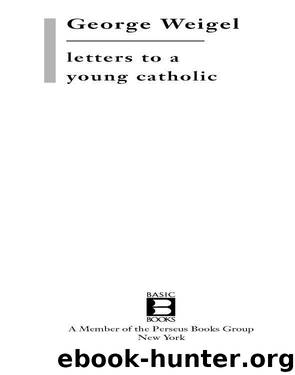Letters to a Young Catholic by George Weigel

Author:George Weigel [Weigel, George]
Language: eng
Format: epub
Publisher: Basic Books
Published: 2010-05-28T04:00:00+00:00
On April 8, 1994, which happened to be Easter Friday, Pope John Paul II celebrated a Mass in the Sistine Chapel to mark the completion of the restoration of the Michelangelo frescoes. That Mass was the occasion for one of the most remarkable homilies of a remarkably eloquent pontificate. Pushing hard against the outside of the theological envelope, the Pope proposed that Michelangelo’s frescoes were a kind of sacrament—a throbbingly visible reality through which we encounter the mystery of the invisible God. These works of “unparalleled beauty” evoked from those who saw them a passion to “profess our faith in God, Creator of all things seen and unseen,” and to proclaim once again our faith in “Christ, King of the Ages, whose kingdom will have no end.”
Despite the fact that they were painted decades apart, Michelangelo’s two Sistine efforts had a deep theological relationship to one another, the Pope suggested: the Last Judgment in fact completes the proto-history of humankind on the ceiling. The beauties depicted in the first six frescos of the creation cycle—God bringing creation out of chaos, God creating the human world in Adam and Eve—give way to the three paintings of the story of Noah, with its reminder that human beings tend always to make a mess of the gift of the created world. But Noah’s betrayal by his sons in his drunkenness (last of the ceiling’s Genesis frescoes and a symbol of enduring human wickedness) isn’t the end of the story. The creation story and the Noah story spill over, on the altar wall, into the story of redemption, synthesized in Michelangelo’s stunning portrayal of the Last Judgment.
The Last Judgment is the “end” of the story in a deeper-than-chronological sense: the Christ who establishes his Kingdom and brings the righteous into it to reign with him forever thereby brings creation to its “end,” in the sense of its purpose and its fulfillment. Life is not random and aimless, these glorious frescoes tell us. There is purpose in the world, divine purpose. In the Risen Christ, returned to judge history and the men and women of history, God brings to completion what he began at the far end of the chapel, by dividing light from darkness in the first moment of creation.
This Christ of the Last Judgment, the Pope continued, is “an extraordinary Christ . . . endowed with an ancient beauty.” And that beauty is deeply enmeshed with “the glory of Christ’s humanity,” for the humanity of Jesus, born of the flesh and blood of Mary, was the vehicle by which God entered the world to set matters aright. Here, the Pope said, we come face-to-face with the Christ who “expresses in himself the whole mystery of the visibility of the Invisible.”
Michelangelo, John Paul suggested, was a man of great Christian conviction and even greater artistic audacity. In his ceiling frescos, he had the courage to “admire with his own eyes” God at the very moment of creation, and especially in the creation of man.
Download
This site does not store any files on its server. We only index and link to content provided by other sites. Please contact the content providers to delete copyright contents if any and email us, we'll remove relevant links or contents immediately.
Resisting Happiness by Matthew Kelly(3303)
The Social Psychology of Inequality by Unknown(2941)
Day by Elie Wiesel(2721)
Designing Your Life by Bill Burnett(2667)
The Giving Tree by Shel Silverstein(2290)
Human Design by Chetan Parkyn(2032)
Angels of God: The Bible, the Church and the Heavenly Hosts by Mike Aquilina(1932)
The Supreme Gift by Paulo Coelho(1902)
Jesus of Nazareth by Joseph Ratzinger(1769)
Hostage to the Devil by Malachi Martin(1757)
Augustine: Conversions to Confessions by Robin Lane Fox(1737)
7 Secrets of Divine Mercy by Vinny Flynn(1691)
Dark Mysteries of the Vatican by H. Paul Jeffers(1676)
The Vatican Pimpernel by Brian Fleming(1668)
St. Thomas Aquinas by G. K. Chesterton(1606)
Saints & Angels by Doreen Virtue(1579)
The Ratline by Philippe Sands(1515)
My Daily Catholic Bible, NABRE by Thigpen Edited by Dr. Paul(1465)
Called to Life by Jacques Philippe(1456)
